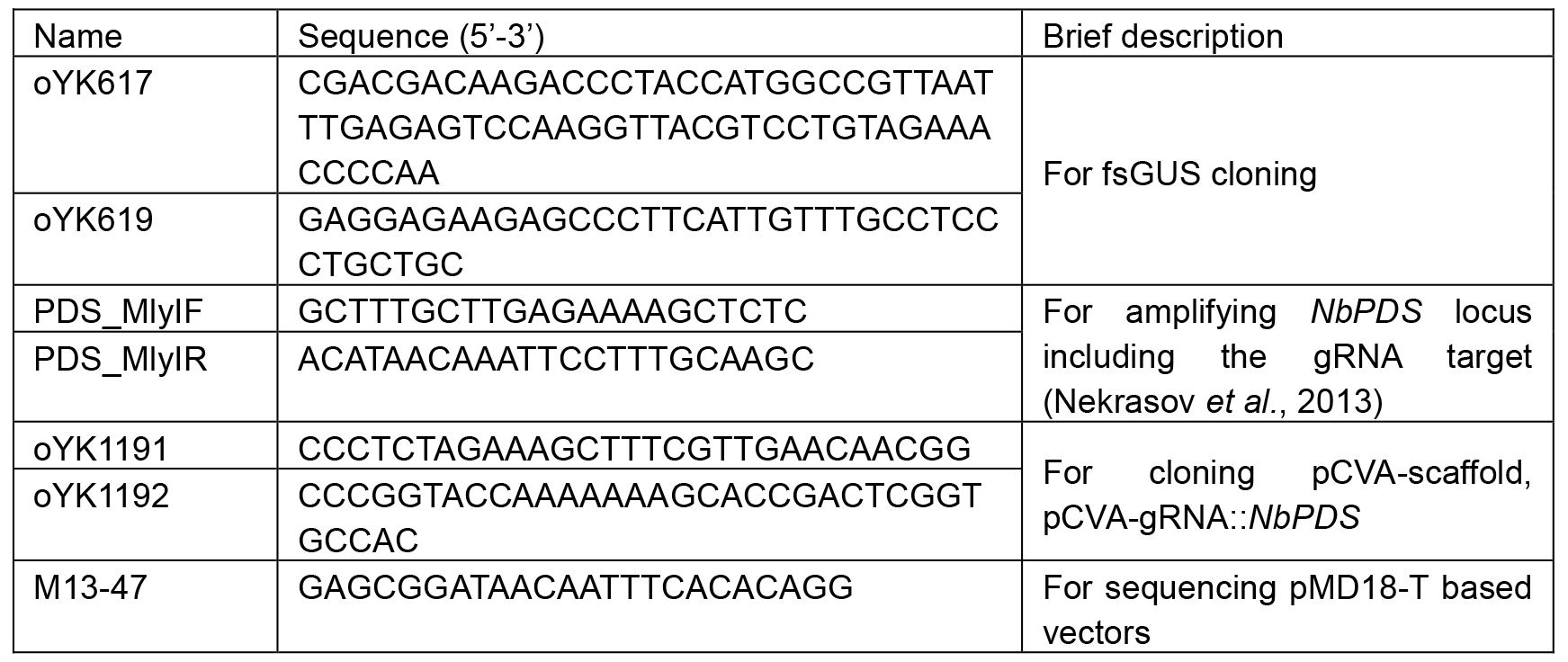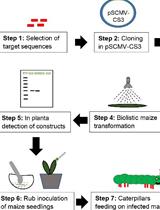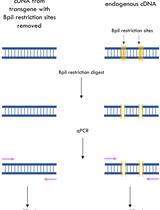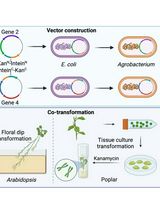- EN - English
- CN - 中文
Use of Geminivirus for Delivery of CRISPR/Cas9 Components to Tobacco by Agro-infiltration
通过农杆菌浸润法使用双生病毒将CRISPR/Cas9组分转入烟草中
发布: 2017年04月05日第7卷第7期 DOI: 10.21769/BioProtoc.2209 浏览次数: 15498
评审: Rainer MelzerKaisa KajalaAnonymous reviewer(s)
Abstract
CRISPR/Cas9 system is a recently developed genome editing tool, and its power has been demonstrated in many organisms, including some plant species (Wang et al., 2016). In eukaryotes, the Cas9/gRNA complexes target genome sites specifically and cleave them to produce double-strand breaks (DSBs), which can be repaired by non-homologous end joining (NHEJ) pathway (Wang et al., 2016). Since NHEJ is error prone, mutations are thus generated. In plants, delivery of genome editing reagents is still challenging. In this protocol, we detail the procedure of a virus-based gRNA delivery system for CRISPR/Cas9 mediated plant genome editing (VIGE). This method offers a rapid and efficient way to deliver gRNA into plant cells, especially for those that are recalcitrant to transformation with Agrobacterium.
Keywords: CRISPR (CRISPR)Background
Genome editing technologies based on viruses have been reported using deconstructed DNA viruses and an RNA virus (Baltes et al., 2014; Ali et al., 2015). Recently, we used a full geminivirus - Cabbage Leaf Curl virus (CaLCuV) (a bipartite begomovirus which infects a wide range of members of the Brassicaceae, including cauliflower) for highly efficient genome editing in one of its hosts, Nicotiana benthamiana, for the first time (Yin et al., 2015).
Materials and Reagents
- 1-ml syringe
- 0.22-μm filter
- Wild type N. benthamiana plants; six to eight-leaf stage transgenic N. benthamiana plants stably expressing oCas9 (Arabidopsis codon optimized Cas9) - KQ334 plant
- Agrobacterium tumefaciens strain GV3101, E. coli DH5α, E. coli DB3.1 (for propagating vectors pJG081)
- The following plasmids are required: pJG081, pKQ334 (Yin et al., 2015), pT-U6p-scaffold-U6t (Yin et al., 2015), pCAMBIA1301, pCAMBIA2300 (www.cambia.org), pCVA (Tang et al., 2010), pCVB (Tang et al., 2010), and pMD18-T vector (Takara Bio, catalog number: D101A)
Notes: - To generate a construct for constitutive expression of oCas9, oCas9 is PCR amplified and subsequently cloned into pJG081 by ligation independent cloning (LIC) technique (Aslanidis and de Jong, 1990) to generate pKQ334.
- pKQ334 is then used to transform N. benthamiana to generate Cas9 transgenic plant - KQ334 plant. pKQ334 can also be used in transient expression of Cas9 in N. benthamiana.
- The pT-U6p-scaffold-U6t is used to generate p-T-U6p-gRNA-scaffold containing gRNA of the target gene by PCR mutagenesis.
- pCVA and pCVB are CaLCuV-based T-DNA vectors. pCVA is used to generate pCVA-gRNA or pCVA-scaffold. pCVB is used in combination with pCVA or its derivatives to generate CaLCuV. pMD18-T vector is used to clone PCR amplicons.
- These vectors can be obtained by contacting Dr. Yule Liu.
- Primers (Table 1)
Table 1. Primers used in this protocol
- TransStart FastPfu DNA polymerase (Beijing TransGen Biotech, catalog number: AP221 )
- Restriction enzymes (New England Biolabs, stored at -20 °C)
- DpnI (New England Biolabs, catalog number: R0176 )
- ApaI (New England Biolabs, catalog number: R0114 )
- SacI (New England Biolabs, catalog number: R0156 )
- PstI (New England Biolabs, catalog number: R3140S )
- KpnI (New England Biolabs, catalog number: R3142S )
- XbaI (New England Biolabs, catalog number: R0145S )
- MlyI (New England Biolabs, catalog number: R0610 )
- 10x Cutsmart buffer
- Antibiotics
Ampicillin (AMRESCO, catalog number: 0339 )
Kanamycin (AMRESCO, catalog number: 0408 )
Rifampicin (Sigma-Aldrich, catalog number: R3501 ) - TIANprep Mini Plasmid Kit (TIANGEN Biotech, catalog number: DP103 ) for plasmid DNA extraction
- Ethanol (Beijing Chemical Factory, catalog number: B0301002 )
- T4 DNA polymerase (Thermo Fisher Scientific, Thermo ScientificTM, catalog number: EP0062 )
- dATP (Takara Bio, catalog number: 4026 )
- Chloroform (Sigma-Aldrich, catalog number: 1601383 )
- Phenol (Sigma-Aldrich, catalog number: P4557 )
- 3 M NaAc (Biovision, catalog number: 2118 )
- dTTP (Takara Bio, catalog number: 4029 )
- DNA Purification Kit (BioMED, catalog number: DH103-01 )
- T4 DNA ligase (Takara Bio, catalog number: 2011A )
- Tryptone (BD, BactoTM, catalog number: 211705 )
- Yeast extract (BD, BactoTM, catalog number: 212750 )
- Sodium chloride (NaCl) (Sigma-Aldrich, catalog number: 31434 )
- Magnesium chloride hexahydrate (MgCl2·6H2O) (Sigma-Aldrich, catalog number: M7304 )
- MES (Sigma-Aldrich, catalog number: M3671 )
- Potassium hydroxide (KOH)
- Acetosyringone (Solarbio, catalog number: A8110-1 )
- DMSO
- Sodium phosphate monobasic (NaH2PO4) (Sigma-Aldrich, catalog number: S3139 )
- Sodium phosphate dibasic (Na2HPO4) (Sigma-Aldrich, catalog number: S3264 )
- Sodium phosphate monobasic (NaH2PO4) (AMRESCO, catalog number: 0571 )
- Sodium phosphate dibasic (Na2HPO4) (AMRESCO, catalog number: 0404 )
- Sodium phosphate monobasic monohydrate (NaH2PO4·H2O)
- Sodium phosphate dibasic heptahydrate (Na2HPO4·7H2O)
- X-gluc (AMRESCO, catalog number: 0919 )
- Methanol (Beijing Chemical Factory, catalog number: B0301005 )
- Potassium ferricyanide (AMRESCO, catalog number: 0713 )
- Triton X-100 (Sigma-Aldrich, catalog number: T9284 )
- PEG 8000 (Sigma-Aldrich, catalog number: 89510 )
- Magnesium chloride hexahydrate (MgCl2·6H2O) (AMRESCO, catalog number: 0288 )
- Magnesium chloride hexahydrate (MgCl2·6H2O) (Sigma-Aldrich, catalog number: 63068 )
- MES (Sigma-Aldrich, catalog number: M3671 )
- Acetosyringone (Sigma-Aldrich, catalog number: D134406 )
- EasyTaq DNA polymerase (Beijing TransGen Biotech, catalog number: AP111 )
- DNAsecure Plant Kit (TIANGEN Biotech, catalog number: DP320 ) for genomic DNA extraction
- Luria-Bertani medium (see Recipes)
- MgCl2 (1 M stock) (see Recipes)
- MES (0.5 M stock) (see Recipes)
- Acetosyringone (1 M stock) (see Recipes)
- Infiltration buffer (see Recipes)
- 2x phosphate buffer (pH 7) (see Recipes)
- X-gluc substrate solution (see Recipes)
- PEG-MgCl2 solution (see Recipes)
Equipment
- Microcentrifuge (Eppendorf)
- PCR cycler (Bio-Rad Laboratories)
- 37 °C and 28 °C incubator; 37 °C and 28 °C shaker
- NanoDrop 1000 spectrophotometer (Thermo Fisher Scientific, model: NanoDrop 1000 ) (for measuring the concentration of the DNA)
- Electrophoresis apparatus (Junyi, Beijing)
- Vacuum apparatus (WILMAD-LABGLASS)
- Glass/plastic beaker
- Autoclave
Software
- ImageJ (https://imagej.nih.gov/ij)
Procedure
文章信息
版权信息
© 2017 The Authors; exclusive licensee Bio-protocol LLC.
如何引用
Yin, K., Han, T. and Liu, Y. (2017). Use of Geminivirus for Delivery of CRISPR/Cas9 Components to Tobacco by Agro-infiltration. Bio-protocol 7(7): e2209. DOI: 10.21769/BioProtoc.2209.
分类
植物科学 > 植物转化 > 农杆菌介导的转化方法
分子生物学 > DNA > 转化
分子生物学 > DNA > DNA 克隆
您对这篇实验方法有问题吗?
在此处发布您的问题,我们将邀请本文作者来回答。同时,我们会将您的问题发布到Bio-protocol Exchange,以便寻求社区成员的帮助。
提问指南
+ 问题描述
写下详细的问题描述,包括所有有助于他人回答您问题的信息(例如实验过程、条件和相关图像等)。
Share
Bluesky
X
Copy link














